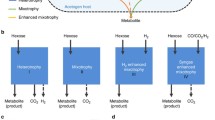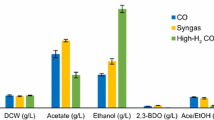Abstract
Cell suspensions of H2/CO2-grown Sporomusa termitida catalyzed an H2-supported synthesis of acetate from CO2 at rates of about 1 μmol acetate x h-1 x mg protein-1. Cells pre-grown on methanol, mannitol, lactate, or glycine also displayed H2-supported acetogenesis from CO2, although at rates 5–85% that of H2/CO2-grown cells. With methanol-grown cell suspensions: the presence of methanol greatly stimulated the rate of H2-supported conversion of 14CO2 to 14C-acetate (which became labeled mainly in the COOH-group); and like-wise the presence of H2 stimulated the conversion of 14CH3OH+CO2 to 14C-acetate (which became labeled mainlyan the CH3-group). Analogous stimulatory effects were observed for cell suspensions pre-grown on methanol + CO2+H2. Furthermore, when H2 (+CO2) was included as a growth substrate with either methanol or lactate: both substrates were used simultaneously; there was no diauxie in the growth of cells or in acetate production; and the molar growth yield of S. termitida was close to that predicted from summation of the yields observed when grown with each substrate alone. These data indicated that S. termitida can grow by mixotrophy, i.e. by the simultaneous use of H2/CO2 and organic compounds for energy. Results are discussed in light of the ability of H2/CO2 acetogens to outprocess methanogens in H2 consumption in the hindgut fermentation of wood-feeding termites.
Similar content being viewed by others
References
Braun K, Gottschalk G (1981) Effect of molecular hydrogen and carbon dioxide on chemo-organotrophic growth of Acetobacterium woodii and Clostridium aceticum. Arch Microbiol 128: 294–298
Breznak JA, Switzer JM (1986) Acetate synthesis from H2 plus CO2 by termite gut microbes. Appl Environ Microbiol 52: 623–630
Breznak JA, Switzer JM, Seitz H-J (1988) Sporomusa termitida sp. nov., and H2/CO2-utilizing acetogen isolated from termites. Arch Microbiol 150: 282–288
Cole SC, Kuwahara SS (1984) Acetylacetone method for glycine improved by use of ammonium citrate as buffer. Clin Chem 30: 1260–1261
Conrad R, Phelps TJ, Zeikus JG (1985) Gas metabolism evidence in support of the juxtaposition of hydrogen-producing and methanogenic bacteria in sewage sludge and lake sediments. Appl Environ Microbiol 50: 595–601
Cookson LJ (1988) The site and mechanism of 14C-lignin degradation by Nasutitermes exitiosus. J Insect Physiol 34: 409–414
Cord-Ruwisch R, Seitz H-J, Conrad R (1988) The capacity of hydrogenotrophic anaerobic bacteria to compete for traces of hydrogen depends on the redox potential of the electron acceptor. Arch Microbiol 149: 350–357
Dolfing J (1988) Acetogenesis. In: Zehnder AJB (ed) Biology of anaerobic microorganisms, chapter 9. Wiley, New York
Eutick ML, O'Brien RW, Slaytor M (1978) Bacteria from the gut of Australian termites. Appl Environ Microbiol 35: 823–828
Greening RC, Leedle JAZ (1989) Enrichment and isolation of Acetitomaculum ruminis gen. nov., sp. nov.: acetogenic bacteria from the bovine rumen. Arch Microbiol 151: 399–406
Heijthuijsen JHFG, Hansen TA (1986) Interspecies hydrogen transfer in cocultures of methanol-utilizing acidogens and sulfate-reducing or methanogenic bacteria. FEMS Microbiol Ecol 38: 57–64
Kane MD, Breznak JA (1991a) Acetonema longum gen. nov. sp. nov., an H2/CO2 acetogenic bacterium from the termite, Pterotermes occidentis. Arch Microbiol 156: 91–98
Kane MD, Breznak JG (1991b) Clostridium mayombei sp. nov., an H2/CO2 acetogenic bacterium from the gut of the African soil-feeding termite, Cubitermes speciosus. Arch Microbiol 156: 99–104
Kerby R, Zeikus JG (1987) Anaerobic catabolism of formate to acetate and CO2 by Butyribacterium methylotrophicum. J Bacteriol 169: 2063–2068
Ljungdahl LG (1986) The autotrophic pathway of acetate synthesis in acetogenic bacteria. Annu Rev Microbiol 40: 415–450
Lovley DR (1985) Minimum threshold for hydrogen metabolism in methanogenic bacteria. Appl Environ Microbiol 49: 1530–1531
Lovley DR, Greening RC, Ferry JG (1984) Rapidly growing rumen methanogenic organism that synthesizes coenzyme M and has a high affinity for formate. Appl Environ Microbiol 48: 81–87
Matin A (1978) Organic nutrition of chemolithotrophic bacteria. Ann Rev Microbiol 32: 433–468
McInerney MJ (1988) Anaerobic hydrolysis and fermentation of fats and proteins. In: Zehnder AJB (ed) Biology of anaerobic microorganisms, chapter 8. Wiley, New York
Odelson DA, Breznak JA (1983) Volatile fatty acid production by the hindgut microbiota of xylophagous termites. Appl Environ Microbiol 45: 1602–1613
Oremland RS (1988) Biogeochemistry of methanogenic bacteria. In: Zehnder AJB (ed), Biology of anaerobic microorganisms, chapter 12. Wiley, New York
Potrikus CJ, Breznak JA (1980) Anaerobic degradation of uric acid by gut bacteria of termites. Appl Environ Microbiol 40: 125–132
Thauer RK, Jungermann K, Decker K (1977) Energy conservation in chemotrophic anaerobic bacteria. Bacteriol Rev 41: 100–180
Wolin MJ (1981) Fermentation in the rumen and human large intestine. Science 213: 1463–1468
Author information
Authors and Affiliations
Rights and permissions
About this article
Cite this article
Breznak, J.A., Blum, J.S. Mixotrophy in the termite gut acetogen, Sporomusa termitida . Arch. Microbiol. 156, 105–110 (1991). https://doi.org/10.1007/BF00290981
Received:
Accepted:
Published:
Issue Date:
DOI: https://doi.org/10.1007/BF00290981




